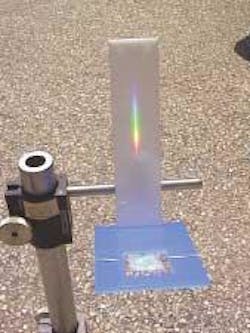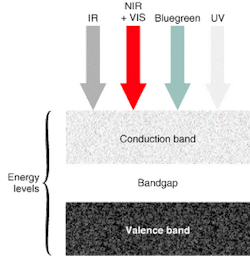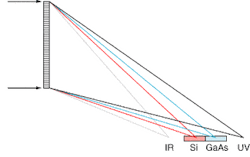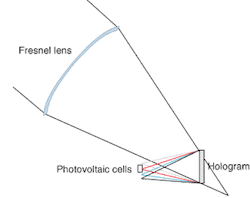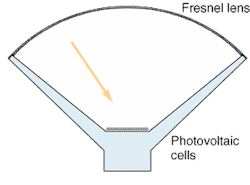Holograms harness the rainbow for efficient solar power
H. JOHN CAULFIELD and JACQUES E. LUDMAN
Solar power generation is attractive for several reasons.1 Earth-based fuels aren't used, so the production of solar energy causes no pollution and has no fuel costs. Smaller power plants can be widely distributed, reducing the need for costly and inefficient long distance power transmission. Solar power plants are neither as attractive to terrorists nor as easily attacked. Moreover, solar farms can operate on otherwise unsuitable land.
Several factors have kept solar energy from taking over as a primary power source. Solar farms do not produce energy at night or when it's cloudy. Also, solar energy is inefficient; the cost of solar energy per kilowatt-hour is still more than that produced by fossil-fuel plants. We cannot do much to change the first problem, except by storing energy in chemical storage systems such as batteries and by backing up solar power with wind power or even fossil-fuel-burning generators. We can, however, attack the second problem head-on by use of a special hologram in some unique ways.
Concentration improves efficiency
"Efficiency" is the fraction of the available solar power converted into electrical power. There are several ways to define available solar power and thus several ways to assign an efficiency number to any solar conversion system. We will, therefore, consider relative improvements that are scale-independent.
Ordinary solar-cell panels found on roofs or on the giant paddles of satellites like the Space Station are inexpensive to build, install, and maintain. They are simple flat panels of low weight. For some purposes, those advantages are desirable. However, the conversion efficiency improves dramatically if we concentrate the light onto a smaller cell. With more concentration, the improvement in efficiency increases. Concentrator systems must be bigger, as they require focusing optics with a minimum distance between the optics and the photovoltaic cell. Also, they require a tracking mechanism that keeps the sun concentrated on the cell as the sun moves across the sky.
Although concentrator systems make solar power cost-competitive, some fundamental aspects of the photovoltaic cells restrict their efficiency. First, these cells degrade in efficiency as their temperature increases. This change is dramatic-approximately 0.5% per °C; the more we concentrate the sunlight, the hotter the cell gets. Concentration improves efficiency, but maintaining a lower temperature in the photovoltaic cell enables a much higher efficiency.
Second, any photovoltaic cell system inevitably makes poor use of the available light energy. This is a fundamental attribute of photons and the semiconductors used for photovoltaic cells. Wavelengths longer than the solar-cell bandgap create no current, only heat. Light with wavelengths equal to or greater than the solar cell bandgap create current, but often do so inefficiently (see Fig. 1).
Incident sunlight falls into four classes relative to a conventional silicon photovoltaic cell. Infrared (IR) generates only heat, which degrades the energy conversion efficiency at other wavelengths. Near-IR and red light have photon energies just in excess of the silicon-cell bandgap, and so produce some useful electrons in the conduction band. The blue-green band also contributes photons with enough energy to produce electrons in the conduction band and thus collectable energy, although these photons waste much of their energy from the viewpoint of power generation, and have a small quantum efficiency. Ultraviolet (UV) light also produces power but even more inefficiently, and causes degradation of the solar cell over time. A major goal for the holographic system is to block the IR and UV, or diffract it away from the solar cell.
Help from holograms
Holograms can disperse the sunlight so that each part of the solar spectrum plays a different role.2, 3 The dispersion allows the addition of more solar cells with larger bandgaps, such as those made of gallium arsenide (GaAs), to convert the higher-energy photons more efficiently at a higher energy (see Fig. 2). A hologram can focus different wavelengths to different regions cleanly (without spectral overlap) and with high efficiency (see photo at top of this page). In such a way, the IR and the UV do not strike solar conversion cells. The near-IR and red light strike a silicon cell to which they are well matched in terms of photon energies. The red/green band strikes a different photovoltaic material, such as GaAs, to which they are well matched.
This design causes four good things to happen at once. The IR light that can only hurt and never help is diffracted away from the solar cells or is undiffracted and never reaches the cells. The useful parts of the spectrum strike photovoltaic cells to which their photon energies are well matched. The deleterious UV is diffracted away from the solar cells or is undiffracted and never reaches the cells. Furthermore, the heat burden normally borne by one photocell is not only reduced by the absence of the IR and UV but also reduced by sharing the burden with a separate cell.
This description shows why solar holography is attractive, but making it work well is quite difficult. One problem is the sheer size of the holograms required; holographic lenses to focus and disperse work well, but they must be large. We have developed a simple way out of that problem (see Fig. 3). In a simpler, less-expensive approach, the focusing is done conventionally, for example, with a Fresnel lens. Then, a hologram is placed in the converging beam to do the dispersion.
A far more difficult problem to overcome is the conflict between the high thickness needed to produce very efficient holograms and the high selectivity of thick holograms. Transmission holograms are angularly selective, while reflection holograms are wavelength selective. The angular selectivity of transmission holograms is more tolerable, as the geometry is reasonably well fixed. An ordinary 100% efficient thick hologram would be so angularly selective as to not focus all of the available sunlight. The required broad bandwidth would not occur. A reflection hologram using a Fresnel lens is not 100% efficient over a broad spectral band, as far as thick-hologram theory and experiment suggest.
The solution to this problem is more difficult to explain.4, 5 First, the thickness of the holographic fringes is the controlling feature, not the thickness of the hologram itself. Judicious choice of the fabricating geometry coupled with relatively thin structures in holographic material capable of high-index modulation permit the creation of high-efficiency, broad-bandwidth holograms. Combining these effects allows either transmission or reflection holograms with 95% efficiency across the solar-useful band that are also tolerant of angle. There are numerous suitable materials.
Solar concentrators come in two configurations. One uses spherical optics and focuses the sunlight to a point. Such systems must track the sun on two axes. The other uses cylindrical optics and focuses the light to a line (see Fig. 4). Such systems track the sun in only one axis, allowing the focused line to shift laterally with sun position along the other axis. Fortunately, these broad-bandwidth holograms are quite insensitive to angular shifts in that other direction, so holographic enhancements work for both types of solar concentrators. For mostly historical reasons, we have worked on cylindrical systems-long cylinders with one side cut away with a curved Fresnel lens inserted. In deployment, many of the troughs will be placed side by side to produce the power needed for any particular application.
REFERENCES
- C. G. Stojanoff et al., Proc. SPIE (1994).
- J. E. Ludman et al., Proc. SPIE, 182 (1992).
- J. E. Ludman et al., Solar Energy 60, 1 (1997).
- J. E. Ludman, Amer. J. Phys. 50, 244 (1982).
- C. G. Stojanoff et al., Proc. SPIE 823, 174 (1987).
H. John Caulfield is chief scientist and Jacques E. Ludman is president of Northeast Photosciences, 18 Flagg Road, Hollis, NH 03049; e-mail: [email protected].
